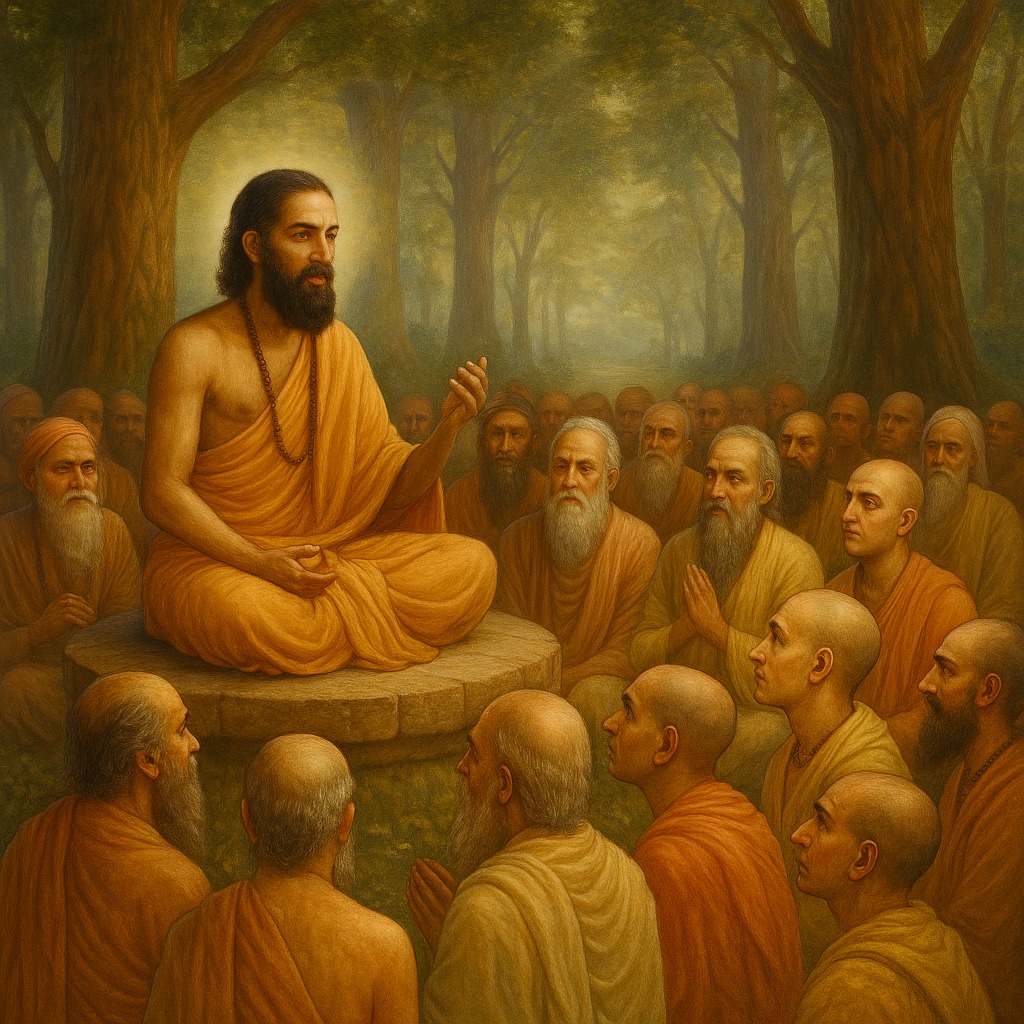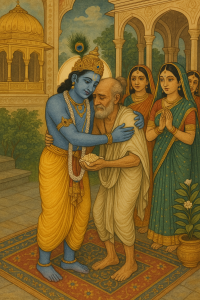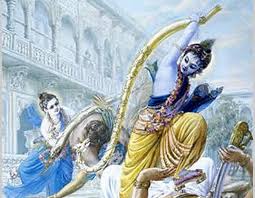The Holy Forest of Naimiṣāraṇya
At the dawn of Kali-yuga, a group of great sages and brāhmaṇas, distressed by the coming of irreligion, gathered in the holy forest of Naimiṣāraṇya, a sacred place where time stands still (naimiṣa means “a moment” or “twinkling of the eye”).
Led by Śaunaka Ṛṣi, these sages assembled to perform a thousand-year sacrifice (satra-yajña) for the spiritual upliftment of the world and protection from the degrading effects of Kali-yuga.
They understood that in this iron age, people would become short-lived, quarrelsome, forgetful, lazy in spiritual practice, and often misguided by false philosophies.
“What is the one means by which people can attain supreme good in this dark age?”
This was the central question they wished to have answered.
The Arrival of Sūta Gosvāmī
While the sages were absorbed in their austerities and discussions, Sūta Gosvāmī, the foremost disciple of Śrīla Vyāsadeva and speaker of the Purāṇas, arrived at their hermitage.
He was glowing with peace and wisdom, having recently witnessed the sacred dialogue between Śukadeva Gosvāmī and Parīkṣit Mahārāja on the banks of the Ganges.
The sages respectfully received him with folded hands and inquired:
“O wise Sūta, you have studied all the scriptures. You have heard the nectar of Śrīmad Bhāgavatam from the lips of Śukadeva. Please tell us:
- What is the essence of all knowledge?
- What is the duty of all living beings, especially in Kali-yuga?
- What are the pastimes of the Supreme Lord, the shelter of all devotees?”
The Birth of the Bhāgavata Recitation Tradition
Sūta Gosvāmī bowed down to the sages and glorified their desire:
“O sages, your question is most glorious. It will purify the entire world.
You have asked about the Supreme Absolute Truth, which is pleasing to the heart and mind.”
He then began to narrate, with great devotion and clarity, the same Śrīmad Bhāgavatam that had delivered Parīkṣit from the fear of death.
Thus began the Naimiṣāraṇya recitation—a sacred tradition of hearing Kṛṣṇa-kathā (the pastimes and glories of Kṛṣṇa), passed down through guru-paramparā, from Vyāsa to Śukadeva, from Śukadeva to Sūta, and from Sūta to all future generations.
Topics Covered in the Recitation
In the presence of sages, Sūta recounted:
- The glories of Śrīmad Bhāgavatam as the spotless Purāṇa,
- The conversation between Nārada and Vyāsa that inspired the Bhāgavatam’s composition,
- The creation of the universe and the role of Lord Nārāyaṇa,
- The avataras of the Lord, especially the descent of Kṛṣṇa in Dvārakā and Vṛndāvana,
- The birth, childhood, and divine exploits of Kṛṣṇa,
- The rāsa-līlā, Govardhana-pūjā, and the liberation of demons,
- The teachings of Prahlāda, Dhruva, Ambarīṣa, and Nārada Muni’s journeys,
- And the final instructions on bhakti as the highest path.
A Spiritual Revolution in Kali-yuga
The sages were mesmerized. They forgot time, hunger, and sleep. Their hearts melted in tears of devotion, and their minds were purified of all material dust.
Sūta declared:
“In Kali-yuga, those who hear Śrīmad Bhāgavatam daily with faith, even if fallen, become purified and attain liberation.
Simply by hearing Kṛṣṇa’s name, one is freed from sins. This Purāṇa is the fruit of the Vedas—it is the sound incarnation of God.”
He emphasized that devotional service (bhakti) to the Supreme Lord, especially through hearing and chanting, is the only means to transcend the age of Kali.
Lessons to Be Learned:
- Hearing about the Lord in the company of saints is the most powerful spiritual practice in Kali-yuga.
- Sincere questions about truth and devotion attract divine answers and mercy.
- Śrīmad Bhāgavatam is the light in the darkness of Kali-yuga, meant for those who seek the highest good.
- By following the tradition of humble hearing, one can cross over birth and death.
- Naimiṣāraṇya represents the eternal dharma assembly, where divine knowledge is constantly shared.
Origin of the Story: Harivaṁśa Purāṇa (closing context) and Śrīmad Bhāgavatam – Canto 1, Chapters 1–4



